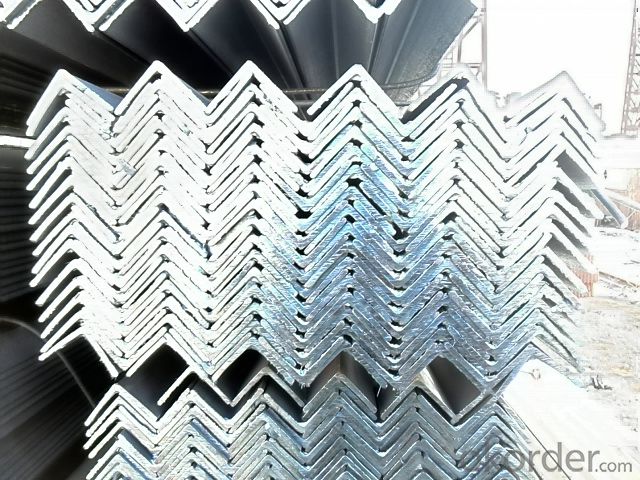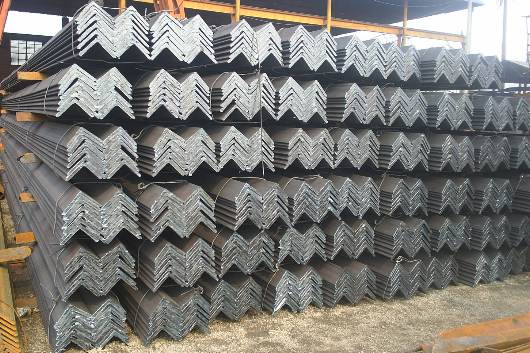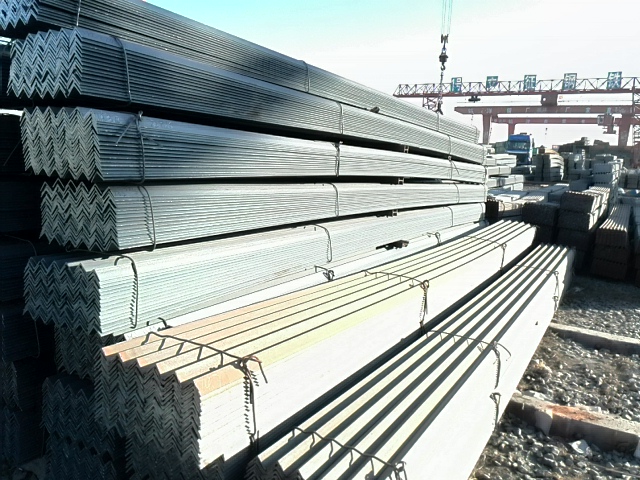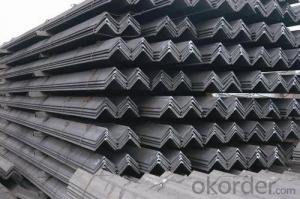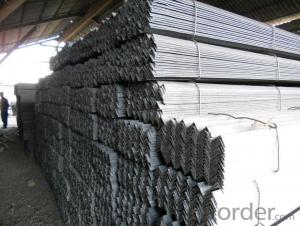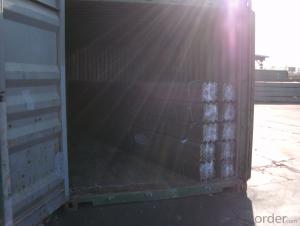Equal Angle Steel Bars with Grade GB-Q235
- Loading Port:
- Tianjin
- Payment Terms:
- TT OR LC
- Min Order Qty:
- 25 m.t.
- Supply Capability:
- 10000 m.t./month
OKorder Service Pledge
OKorder Financial Service
You Might Also Like
Product Description:
OKorder is offering high quality Hot Rolled Equal Angle Steel at great prices with worldwide shipping. Our supplier is a world-class manufacturer of steel, with our products utilized the world over. OKorder annually supplies products to European, North American and Asian markets. We provide quotations within 24 hours of receiving an inquiry and guarantee competitive prices.
Product Applications:
Hot Rolled Equal Angle Steels are ideal for structural applications and are widely used in the construction of buildings and bridges, and the manufacturing, petrochemical, and transportation industries.
Product Advantages:
OKorder's Hot Rolled Equal Angle Steels are durable, strong, and resist corrosion.
Main Product Features:
· Premium quality
· Prompt delivery & seaworthy packing (30 days after receiving deposit)
· Corrosion resistance
· Can be recycled and reused
· Mill test certification
· Professional Service
· Competitive pricing
Product Specifications:
Manufacture: Hot rolled
Grade: Q195 – 235
Certificates: ISO, SGS, BV, CIQ
Length: 6m – 12m, as per customer request
Packaging: Export packing, nude packing, bundled
EQUAL ANGLES SIZES |
| ||
a(mm) | a1(mm) | thickness(mm) | length |
25 | 25 | 2.5---3.0 | 6M/12M |
30 | 30 | 2.5---4.0 | 6M/12M |
38 | 38 | 2.5 | 6M/12M |
38 | 38 | 3.0---5.0 | 6M/12M |
40 | 40 | 3.0---6.0 | 6M/12M |
50 | 50 | 3 | 6M/12M |
50 | 50 | 3.7---6.0 | 6M/9M/12M |
60 | 60 | 5.0---6.0 | 6M/9M/12M |
63 | 63 | 6.0---8.0 | 6M/9M/12M |
65 | 65 | 5.0---8.0 | 6M/9M/12M |
70 | 70 | 6.0---7.0 | 6M/9M/12M |
75 | 75 | 5.0---10.0 | 6M/9M/12M |
80 | 80 | 6.0---10.0 | 6M/9M/12M |
90 | 90 | 6.0---10.0 | 6M/9M/12M |
100 | 100 | 6.0---12.0 | 6M/9M/12M |
120 | 120 | 8.0-12.0 | 6M/9M/12M |
125 | 125 | 8.0---12.0 | 6M/9M/12M |
130 | 130 | 9.0-12.0 | 6M/9M/12M |
140 | 140 | 10.0-16.0 | 6M/9M/12M |
150 | 150 | 10---15 | 6M/9M/12M |
160 | 160 | 10---16 | 6M/9M/12M |
180 | 180 | 12---18 | 6M/9M/12M |
200 | 200 | 14---20 | 6M/9M/12M |
FAQ:
Q1: Why buy Materials & Equipment from OKorder.com?
A1: All products offered byOKorder.com are carefully selected from China's most reliable manufacturing enterprises. Through its ISO certifications, OKorder.com adheres to the highest standards and a commitment to supply chain safety and customer satisfaction.
Q2: What makes stainless steel stainless?
A2: Stainless steel must contain at least 10.5 % chromium. It is this element that reacts with the oxygen in the air to form a complex chrome-oxide surface layer that is invisible but strong enough to prevent further oxygen from "staining" (rusting) the surface. Higher levels of chromium and the addition of other alloying elements such as nickel and molybdenum enhance this surface layer and improve the corrosion resistance of the stainless material.
Q3: Can stainless steel rust?
A3: Stainless does not "rust" as you think of regular steel rusting with a red oxide on the surface that flakes off. If you see red rust it is probably due to some iron particles that have contaminated the surface of the stainless steel and it is these iron particles that are rusting. Look at the source of the rusting and see if you can remove it from the surface.
Images:
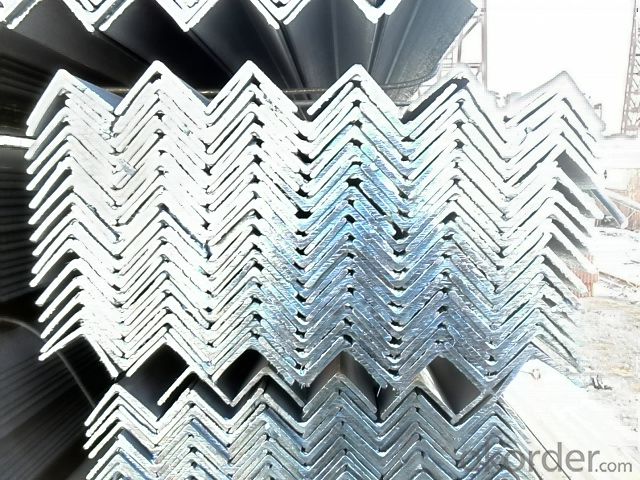
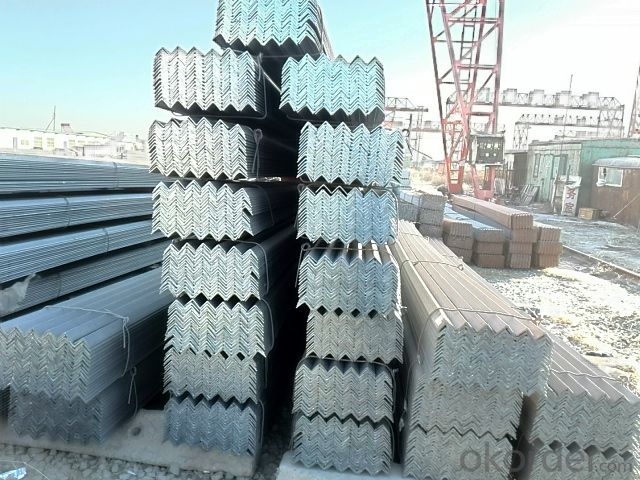
- Q: Can steel angles be used for acoustic isolation or noise barriers?
- While steel angles have the potential to be used for acoustic isolation or noise barriers, their effectiveness may not be on par with materials specifically engineered for this purpose. Sound waves can be somewhat reduced by steel angles through reflection and absorption, but this depends on factors like steel thickness, density, and barrier design. It's worth noting that steel angles are not typically intended for soundproofing, so relying solely on them may not yield optimal acoustic isolation. To achieve optimal results, it is advised to explore specialized materials and techniques exclusively designed for noise barriers.
- Q: How do steel angles contribute to the seismic resilience of a structure?
- Steel angles are an essential component in enhancing the seismic resilience of a structure. These angled steel members are commonly used in construction to provide additional strength and stability, particularly in earthquake-prone areas. One way steel angles contribute to the seismic resilience of a structure is through their ability to resist lateral forces caused by seismic activities. During an earthquake, buildings are subjected to horizontal forces that can cause significant damage. Steel angles are strategically placed within the structure to help distribute and dissipate these forces, thus reducing the overall impact on the building. By acting as braces or stiffeners, steel angles enhance the structural integrity and prevent excessive deformation or collapse. Furthermore, steel angles are often used in conjunction with other seismic design strategies, such as moment frames or shear walls. These elements work together to create a robust and flexible structural system that can withstand the dynamic forces generated during an earthquake. Steel angles are typically integrated into these systems to provide additional reinforcement and increase the overall strength and rigidity of the structure. In addition to their role in resisting lateral forces, steel angles also contribute to the seismic resilience of a structure by improving its load-carrying capacity. By distributing loads more efficiently, steel angles help to reduce the stress on individual components, preventing localized failures and ensuring the overall stability of the structure. Moreover, steel angles are highly durable and possess excellent material properties, such as high tensile strength and toughness. This makes them well-suited for withstanding the dynamic loading and cyclic motions associated with earthquakes. Steel angles are also resistant to corrosion, which is crucial for maintaining the long-term structural integrity and overall performance of a building in seismic events. In conclusion, steel angles play a crucial role in enhancing the seismic resilience of a structure. By resisting lateral forces, improving load-carrying capacity, and providing durability, they contribute to the overall stability and integrity of the building. Incorporating steel angles into the design and construction process is essential for creating structures that can withstand seismic activities and ensure the safety of occupants.
- Q: What are the tolerance specifications for steel angles?
- The tolerance specifications for steel angles can differ based on various organizations and industries' specific standards and requirements. However, in general, the tolerance specifications for steel angles typically encompass measurements for dimensions like leg length, thickness, and straightness. Leg length tolerance ensures that the angle's legs are within an acceptable range of the desired measurement by allowing a certain deviation from the specified leg length. For instance, a tolerance specification of ±1/8 inch permits the leg length to deviate by up to 1/8 inch in either direction from the specified dimension. Thickness tolerance denotes the allowable deviation in the thickness of the steel angle. This specification guarantees consistency and adherence to an acceptable range of thickness. It is usually expressed as a percentage or an absolute value. For example, a tolerance specification of ±10% permits the thickness to deviate by up to 10% above or below the specified dimension. Straightness tolerance ensures that the steel angle is not bent or twisted and meets the required straightness criteria. It is commonly measured by the maximum allowable deviation from a straight line. This tolerance specification guarantees ease of fitting and alignment during construction or manufacturing processes. It is important to note that the specific tolerance specifications for steel angles may vary depending on the intended application, industry standards, and regulatory requirements. Therefore, it is recommended to consult the manufacturer, industry associations, or governing bodies for accurate and up-to-date information on the tolerance specifications for steel angles by referring to the relevant standards, codes, or specifications.
- Q: Can steel angles be used in the construction of power plants?
- Steel angles are indeed suitable for use in power plant construction. They are frequently employed to provide structural support and stability, as well as to withstand heavy loads. In power plant construction, steel angles have several applications, including framing structural components, supporting machinery, reinforcing concrete structures, and ensuring the overall structural integrity of the plant. Moreover, steel angles are highly resistant to corrosion, which is especially crucial in power plants where they are exposed to high temperatures, moisture, and chemicals. Thus, the versatility, strength, and durability of steel angles make them an excellent option for constructing power plants.
- Q: What are the limitations of using steel angles in corrosive or saltwater environments?
- The main limitations of using steel angles in corrosive or saltwater environments are their susceptibility to corrosion and potential for accelerated deterioration. Steel angles are prone to rusting and corrosion when exposed to moisture and saltwater, which can weaken the structural integrity of the material over time. To mitigate these limitations, protective coatings or alternative materials such as stainless steel or galvanized steel can be used.
- Q: Can steel angles be used as framing members in buildings?
- Yes, steel angles can be used as framing members in buildings. Steel angles are commonly used in structural applications due to their strength, durability, and versatility. They provide excellent support and stability, making them suitable for framing various building elements such as walls, floors, and roofs.
- Q: How do you calculate the compression strength of a steel angle?
- To calculate the compression strength of a steel angle, you need to consider its geometric properties and the material properties of the steel. First, you should determine the cross-sectional area of the steel angle. This can be calculated by multiplying the thickness of the angle by the width of the flange and subtracting the area of any holes or cutouts in the angle. Next, you need to determine the yield strength of the steel. The yield strength is the maximum stress that the steel can withstand before it starts to deform permanently. This information can usually be obtained from the steel manufacturer or reference materials. Once you have the cross-sectional area and the yield strength, you can calculate the compression strength using the formula: Compression strength = Yield strength * Cross-sectional area It's important to note that this calculation assumes that the steel angle is subjected to a purely compressive load, without any bending or torsional forces. If the angle is subjected to other types of loading, such as bending or torsion, additional calculations or testing may be required to accurately determine its strength.
- Q: Can steel angles be used in agricultural or farming structures?
- Steel angles are a versatile option for agricultural or farming structures. With their L-shaped profile, they offer exceptional structural support and are commonly used in construction projects. In the realm of agricultural or farming structures, steel angles serve various purposes, such as framing barns, sheds, or storage facilities. They are also suitable for constructing fencing systems, gates, or other enclosures for livestock. The durability and strength of steel angles make them well-suited for enduring the harsh outdoor conditions and heavy loads typically encountered in agricultural and farming environments. Moreover, steel angles can be easily welded or bolted together, allowing for flexible and efficient construction methods. In conclusion, incorporating steel angles into agricultural or farming structures is a practical and dependable choice.
- Q: Can galvanized square tubes and angle iron be welded together?
- Yes, if the requirement is not high, it can be welded directly. If the requirement is high, the zinc coating on the galvanized square pipe can be polished off before welding, and then welded. However, two kinds of welding methods, welding well, must be carried out at the weld corrosion. Now there is a special coating for hot-dip galvanizing on the market. It is characterized by high zinc content and 96% zinc content. It can provide similar anticorrosive effect to hot-dip galvanizing for repairing parts.
- Q: What is the process of cold bending steel angles?
- The process of cold bending steel angles involves using hydraulic or mechanical forces to gradually shape the steel angle into a desired curve or angle without the use of heat. This is achieved by carefully manipulating and applying pressure to the steel angle until it is bent to the desired shape.
Send your message to us
Equal Angle Steel Bars with Grade GB-Q235
- Loading Port:
- Tianjin
- Payment Terms:
- TT OR LC
- Min Order Qty:
- 25 m.t.
- Supply Capability:
- 10000 m.t./month
OKorder Service Pledge
OKorder Financial Service
Similar products
Hot products
Hot Searches



